3.1 Review of Basic Genetic Mechanisms
You have probably studied the mechanisms of gene action and reproduction in a biology course, so we will not go into detail on these processes here. But a brief review of them, focused on their implications for psychology, may be useful.
How Genes Affect Behavior
1
How can genes affect behavioral traits through their role in protein synthesis?
Sometimes, as a sort of shorthand (which we will use occasionally in this book), researchers speak of genes “for” particular behavioral traits. For example, they might speak of genes for singing ability, for aggression, or for cooperation. However, it is more accurate, if a bit more awkward, to say that genes are associated with behavior. Genes never produce or control behavior directly. All the effects that genes have on behavior occur through their role in building and modifying the physical structures of the body. Those structures, interacting with the environment, produce behavior. Thus, a gene might influence singing ability by promoting the development of a brain system that analyzes sounds or by promoting certain physical aspects of the vocal cords. Similarly, a gene might affect aggressiveness by fostering the growth of brain systems that organize aggressive behavior in response to irritating stimuli. In a sense, all genes that contribute to the body’s development are “for” behavior, since all parts of the body are involved in behavior. Especially relevant for behavior, however, are genes that contribute to the development of sensory systems, motor systems (muscles and other organs involved in movement), and, most especially, the nervous system (which includes the brain).
Genes Provide the Codes for Proteins
Genes affect the body’s development through, and only through, their influence on the production of protein molecules. We are what we are, biologically speaking, because of our proteins. A class of proteins called structural proteins forms the structure of every cell of the body. Another, much larger class called enzymes controls the rate of every chemical reaction in every cell.
Physically, genes are components of extremely long molecules of a substance called DNA (deoxyribonucleic acid). These molecules exist in the egg and sperm cells that join to form a new individual, and they replicate themselves during each cell division in the course of the body’s growth and development. A replica of your whole unique set of DNA molecules exists in the nucleus of each of your body’s cells, where it serves to code for and regulate the production of protein molecules.
Each protein molecule consists of a long chain of smaller molecules called amino acids. A single protein molecule may contain anywhere from several hundred up to many thousand amino acids in its chain. There are a total of 20 distinct amino acids in every form of life on earth, and they can be arranged in countless sequences to form different protein molecules. Some portions of the DNA in your cells serve as templates (that is, as molds or patterns) for producing another molecular substance called RNA (ribonucleic acid), which in turn serves as a template for producing protein molecules. Scientists often describe a gene as a segment of a DNA molecule that contains the code that dictates the particular sequence of amino acids for a single type of protein. With that definition, geneticists have determined that human beings (and also chimpanzees and mice) have between 20,000 and 25,000 genes (International Human Genome Sequencing Consortium, 2004).
59
Recent molecular work has led many geneticists to change their definition of a gene so that it includes portions of DNA that have other functions, not just the coding of protein molecules (The ENCODE Project Consortium, 2012). We now know that most of the DNA in human cells does not code for proteins. Although much of this noncoding DNA was once called “junk DNA” because scientists believed that it had no purpose, recent evidence indicates that about 80 percent of DNA serves some function, such as regulating the activity of the coding DNA (The ENCODE Project Consortium, 2012; Pennisi, 2012). Geneticists now distinguish between coding genes, which code for unique protein molecules, and regulatory genes, which work through various biological means to help activate or suppress specific coding genes and thereby influence the body’s development. Recent research comparing human and chimpanzee DNA suggests that the biggest genetic differences between the two species lie in certain regulatory genes that affect the development of the brain (Prabhakar et al., 2006; McClean et al., 2011).
Genes Work Only Through Interaction with the Environment
2
What does it mean to say that genes can influence behavioral traits only through interaction with the environment? How are genes involved in long-term behavioral changes that derive from experience?
At every level, from biochemical to behavioral, the effects of genes are entwined with the effects of the environment. Environment, as used in this context, refers to every aspect of an individual and his or her surroundings except the genes themselves. It includes the nourishing womb and maternal bloodstream before birth; the internal chemical environment of the individual; and all the events, objects, and other individuals encountered after birth. Foods—a part of the environment—supply genes with amino acids, which are needed to manufacture proteins. Environmental effects also help to turn genes “on” and “off,” resulting in bodily changes that alter the individual’s behavioral capacity. Such changes can occur in adulthood as well as earlier in development. For example, physical exercise modifies the chemical environment of muscle cells in a way that activates genes that promote further growth of the muscle. One’s body and behavioral capacities result from a continuous, complex interplay between genes and environment (see Figure 3.1). In no sense is one more basic than the other. Remember, genes are always expressed in a context.
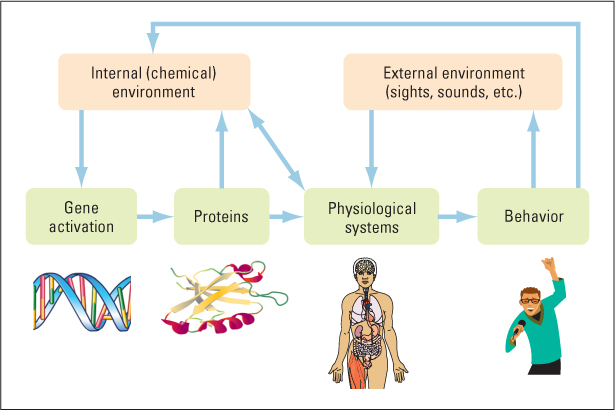
60
The world of reptiles provides a fascinating example of the role of context in gene expression. You likely learned in biology class that being male or female is a matter of genes. In humans, the 23rd chromosome pair is called the “sex chromosome,” with females having two X chromosomes (XX) and males one X and one Y. This is how sex is determined in other mammals as well. This is not the case for many reptiles, however. For many turtles, alligators, and crocodiles, sex is determined not by differences in genes, but by differences in the temperature at which the eggs are incubated. Theoretically, we could have genetically identical twin reptiles, one male and one female. Genes still provide the critical instructions for developing into a male or female animal, but the context in which the genes are expressed (a warm versus a cooler one) determines which sex that will be. A tour guide in the Galápagos Islands (about 600 miles off the coast of Ecuador) told how he remembered which temperature produces which sex for the Galápagos giant tortoises: “Hot chicks and cool dudes.”

Researchers have begun to learn about specific mechanisms through which experiences can activate genes and thereby alter the individual’s brain and behavior. One well-studied example has to do with parental behavior in mice and rats. Adult mice and rats that have not given birth will normally avoid newborns of their species that are placed in their cage. However, if exposed to newborns continuously for several hours or more, they gradually begin to care for them. This change in behavior involves the environmental induction of gene activity (Brown et al., 1996; Numan, 2007). The sight, sound, or smell of newborns activates a particular gene. The activated gene produces a protein molecule that stimulates activity in a specific cluster of brain cells that are known to be crucial for the motivation and organization of such behaviors as retrieving young to a nest and hovering over them. The result is that a mouse or rat that previously did not take care of young is transformed into a mouse or rat that does.
There is good reason to believe that all sorts of prolonged behavioral effects that derive from experience, including those that we call “learning,” involve the activation of genes (Johnston & Edwards, 2002; Spencer et al., 2009). The experience activates genes, which produce proteins, which in turn alter the function of some of the neural circuits in the brain and thereby change the manner in which the individual behaves.
Distinction Between Genotype and Phenotype
3
How can the same genotype produce various phenotypes?

Geneticists use the term genotype to refer to the set of genes that the individual inherits and the term phenotype to refer to the observable properties of the body and behavioral traits. The same genes can have different effects, depending on the environment and the mix of other genes. Two individuals with the same genotype can be quite different in phenotype as a result of differences in their environments. Genetically identical rats will differ phenotypically in their behavior toward infant rats if one has been previously exposed to infant rats and the other has not. Genetically identical human twins will differ in size if they have been exposed differently to growth-promoting factors in their environments (see Figure 3.2), and they will differ in behavior if they have been subjected to different learning experiences.
How Genes Are Passed Along in Sexual Reproduction
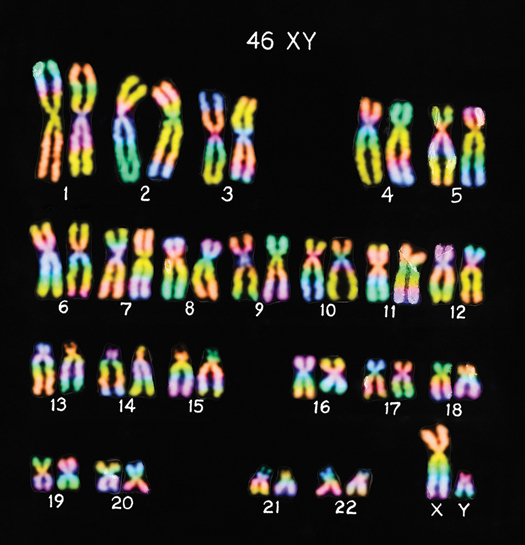
Genes not only provide the codes for building proteins; they also serve as the biological units of heredity. They are replicated and passed along from parents to offspring, and they are the cause of offsprings’ resemblance to parents.
61
To understand how genes are passed along in sexual reproduction, it is useful to know something about their arrangement within cells. The genetic material (strands of DNA) exists in each cell in structures called chromosomes, which are usually dispersed throughout the cell nucleus. Just prior to cell division, however, the chromosomes condense into compact forms that can be stained, viewed through a microscope, and photographed. The normal human cell has 23 pairs of chromosomes. Twenty-two of these are true pairs in both the male and the female, in the sense that each chromosome looks like its mate and contains similar genes. The remaining pair is made up of the sex chromosomes. In the normal human male cell, that “pair” consists of a large chromosome labeled X and a small chromosome labeled Y (see Figure 3.3). Genetically, the only difference between the sexes is that females have two X chromosomes (XX–a true pair) rather than the XY of the male.
The Production of Genetically Diverse Egg and Sperm Cells
When cells divide to produce new cells other than egg or sperm cells, they do so by a process called mitosis. In mitosis, each chromosome precisely replicates itself and then the cell divides, with one copy of each chromosome moving into each of the two cell nuclei thus formed. Because of the faithful copying of genetic material in mitosis, all your body’s cells, except your egg or sperm cells, are genetically identical to one another. The differences among different cells in your body—such as muscle cells and skin cells—arise from the differential activation of their genes, not from different gene content.
4
How does meiosis produce egg or sperm cells that are all genetically different from one another?
When cells divide to produce egg or sperm cells, they do so by a different process, called meiosis, which results in cells that are not genetically alike (depicted in Figure 3.4). During meiosis, each chromosome replicates itself once, but then the cell divides twice. Before the first cell division, the chromosomes of each pair line up next to one another and exchange genetic material in a random manner.
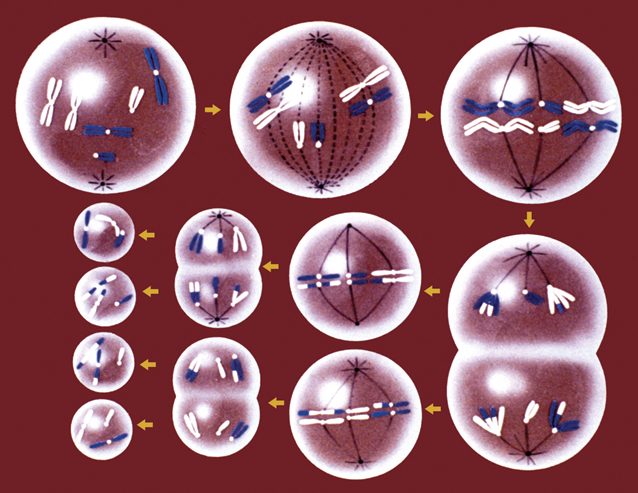
62
Although the chromosomes in each pair look the same, they do not contain precisely the same genes. The result of this random exchange of genetic material and of the subsequent cell divisions is that each egg or sperm cell produced is genetically different from any other egg or sperm cell and contains only half of the full number of chromosomes (one member of each of the 23 pairs).
The Genetic Diversity of Offspring
It may seem ironic that the very cells you use for “reproduction” are the only cells in your body that cannot, in theory, reproduce you. They are the only cells in your body that do not have all your genes. In sexual reproduction you are, of course, not really reproducing yourself. Rather, you are creating a genetically unique individual who has half of your genes and half of your partner’s. When a sperm and an egg unite, the result is a single new cell, the zygote, which contains the full complement of 23 paired chromosomes. One member of each of these pairs comes from each parent. The zygote then grows, through mitosis, eventually to become a new person. Because each sperm or egg is different from any other sperm or egg (even from the same parent), each zygote is different from any other.
5
What is the advantage of producing genetically diverse offspring?
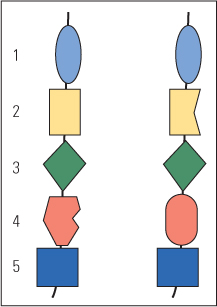
The value of sex, as opposed to simple cloning (the asexual production of genetically identical offspring), apparently lies in the production of genetically diverse offspring. In a world where the environment keeps changing, genes have a better chance of surviving if they are rearranged at each generation in many different ways, to produce different kinds of bodies, than if they are all put into the same kind of body. This is an almost literal example of the old saying, “Don’t put all your eggs in one basket.” By producing diverse offspring, parents are reducing the chance that all of their offspring will die as a result of some unforeseen change in the environment.
The only people who are genetically identical to each other are identical twins. They are formed when two bundles of cells separate from each other during the early mitotic divisions following the formation of a zygote. Because they originate from one zygote, identical twins are also known as monozygotic twins. Fraternal twins, or dizygotic twins, originate from two zygotes, each formed from different egg and sperm cells. Fraternal twins have the same degree of genetic similarity as any two nontwin siblings. In later chapters, you will see how psychologists make use of twins in research to understand how much of the variability in certain psychological traits results from differences in people’s genes, as opposed to differences in their environments.
Consequences of the Fact That Genes Come in Pairs
You have seen that genes exist on long DNA strands in chromosomes, rather like beads on a string, and that chromosomes come in pairs. The two genes that occupy the same locus (location; plural loci) on a pair of chromosomes are sometimes identical to each other and sometimes not. When they are identical, the individual is said to be homozygous [hō-mō-zī’-gos] at that locus, and when they are not identical, the individual is said to be heterozygous [hě t′-er-ō-zī′-ges] at that locus (see Figure 3.5). Different genes that can occupy the same locus, and thus can potentially pair with each other, are called alleles[e-lēl′z].
6
What is the difference between a dominant and a recessive gene (or allele)?
For example, a gene for a straight hairline and a gene for a widow’s peak in humans are alleles because they can occupy the same locus. If you are homozygous for a widow’s peak, you have two copies of a gene that manufactures an enzyme that makes your hairline dip in the middle of your forehead. What if you were heterozygous for hairline, with one copy of the allele for a widow’s peak and one copy for a straight hairline? In this case, you would have a widow’s peak, no different from the hairline you would have if you were homozygous for a widow’s peak. This effect is described by saying that the allele for a widow’s peak is dominant and the one for a straight hairline is recessive. A dominant gene (or allele) is one that will produce its observable effects in either the homozygous or the heterozygous condition, and a recessive gene (or allele) is one that will produce its effects in the homozygous condition only. But not all pairs of alleles manifest dominance or recessiveness. Some pairs blend their effects. For example, if you cross red snapdragons (a kind of flower) with white snapdragons, the offspring will have pink flowers because neither the red nor the white allele is dominant over the other.
63
Mendelian Pattern of Heredity
The idea that the units of heredity come in pairs and that one member of a pair can be dominant over the other was developed in the mid-nineteenth century by an Austrian monk named Gregor Mendel. In a typical experiment, Mendel would start with two purebred strains of pea plants that differed in one or more easily observed traits. He could cross-pollinate them to observe the traits of the offspring, called the F1 (first filial) generation. Then he would pollinate the F1 peas with pollen from other F1 peas to produce the F2 (second filial) generation.
In one experiment, for example, Mendel cross-pollinated a strain of pea plants that regularly produced round seeds with a strain that regularly produced wrinkled seeds. His famous findings were that (a) all of the F1 generation had round seeds and (b) three-fourths of the F2 generation had round seeds and one-fourth had wrinkled seeds.
7
Why do three-fourths of the offspring of two heterozygous parents show the dominant trait and one-fourth show the recessive trait?
Mendel’s findings make perfect sense if we assume that seed texture is controlled by a single pair of genes, with the allele for round dominant over that for wrinkled. To illustrate this, let us use the capital letter R to stand for the dominant, round-producing allele and the small letter r for the recessive, wrinkle-producing allele. The purebred round strain is homozygous for the “round” allele (RR), and the purebred wrinkled strain is homozygous for the “wrinkled” allele (rr). (Purebred strains are homozygous for all traits.) Because one allele must come from each parent, the only possible result for the F1 generation, produced by crossing the two purebred strains, is the heterozygous condition (Rr). This explains why all the F1 peas in Mendel’s experiment were round. At the next step, when Rr peas receive pollen from other Rr peas to produce the F2 generation, four equally likely combinations can occur: (1) an R from each parent (RR), (2) an R from the female parent and an r from the male (Rr), (3) an r from the female parent and an R from the male (rR), and (4) an r from each parent (rr). (See Figure 3.6). Since only one of these possible outcomes (rr) is wrinkled, the expectation is that one-fourth of the F2 generation will be wrinkled and the other three-fourths, round. This is just what Mendel found.
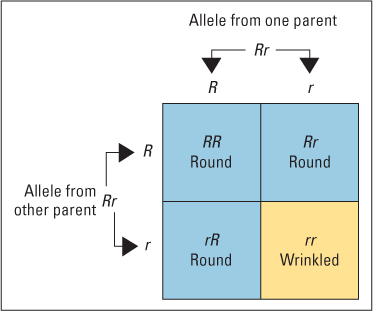
Whenever a trait is inherited in a pattern like that observed by Mendel, we can assume that the trait results from variation in alleles at a single gene locus that interact in a dominant-recessive manner.
The Double-edged Sword of Sickle-Cell Anemia
8
Why might a disease caused by two recessive genes persist in the gene pool?
There are a handful of diseases caused by a single pair of recessive genes that inevitably lead to an early death (or were deadly before the advent of modern medicine). Among these is sickle-cell anemia, a disease that interferes with the transport of oxygen in the blood. In healthy individuals, the red blood cells that carry the oxygen are usually disk shaped. In patients with sickle-cell anemia, the blood cells are distorted, shaped like a sickle, or crescent moon. Because of their shape, the sickled cells tend to pile up and block small blood vessels, resulting in pain and destruction of tissue, as well as other complications that can be fatal. Given that natural selection is supposed to favor characteristics that enhance the chances of an individual surviving, and that genes that essentially kill their host do not get passed on to future generations, why haven’t sickle-cell-anemia genes been eliminated?
The answer is that although having two recessive genes for sickled cells was often a death sentence before the advent of modern medicine, having just one recessive gene and one normal, dominant gene (that is, being heterozygous at that locus) provided some benefit. The genes associated with sickle-cell anemia originated in areas of the globe where malaria was common, chiefly in Africa. People with a single sickle-cell gene are less likely to die of malaria because their red blood cells are poor at supporting the growth of the malaria parasite. People who have one recessive gene (carriers) living in these areas are thus more likely to live to reproduce than noncarriers, keeping the recessive and potentially deadly gene in the gene pool. The benefit is not to those who have the disease, but to those who are carriers (Desai & Dhanani, 2004).
64
SECTION REVIEW
Genes affect behavior by affecting the bodily structures involved in behavior.
Nature of Genetic Influence
- Through their influence on protein synthesis, genes affect bodily structures and behavior.
- Genes act in concert with the environment, not in isolation. For example, environmental cues can activate genes that make rats or mice nurturant to newborns.
Meiosis and Sexual Reproduction
- Meiosis results in egg and sperm cells that are genetically unique and contain only half the full number of chromosomes.
- Meiosis involves random assortment of paired genes.
- Genetic diversity produced by sexual reproduction promotes genes’ survival by reducing the chance that all offspring will die.
Gene Pairing
- Paired genes, which occupy the same locus (location) on a pair of chromosomes, may be identical (homozygous) or different (heterozygous). Gene variations that can occupy the same locus are called alleles.
- Mendel’s discovery of consistent ratios of traits in offspring of cross-pollinated strains of peas led to the gene concept and to the concepts of dominance and recessiveness.
- Some genetic conditions, such as sickle-cell anemia, carry both risks and benefits for the individuals born with them.